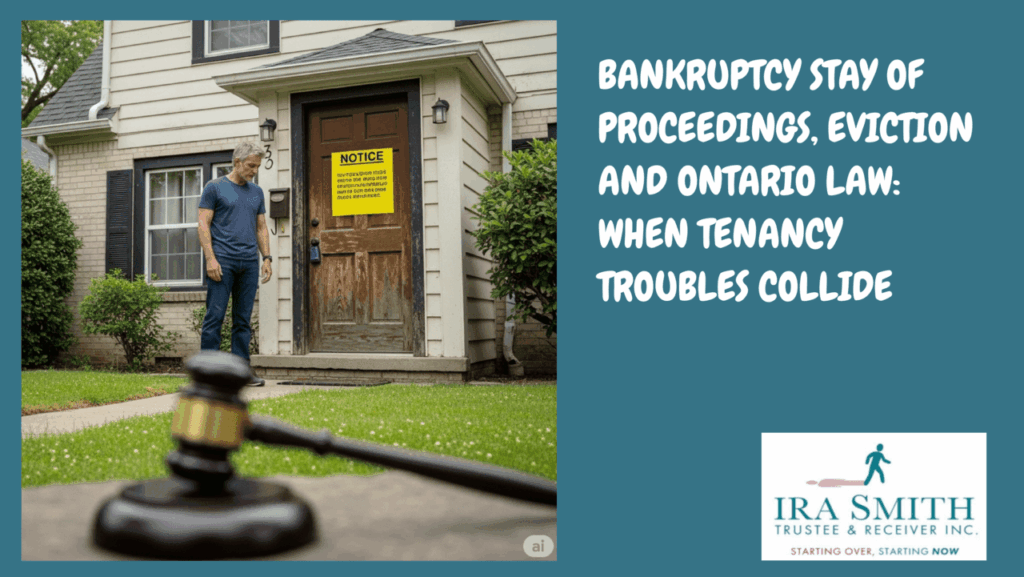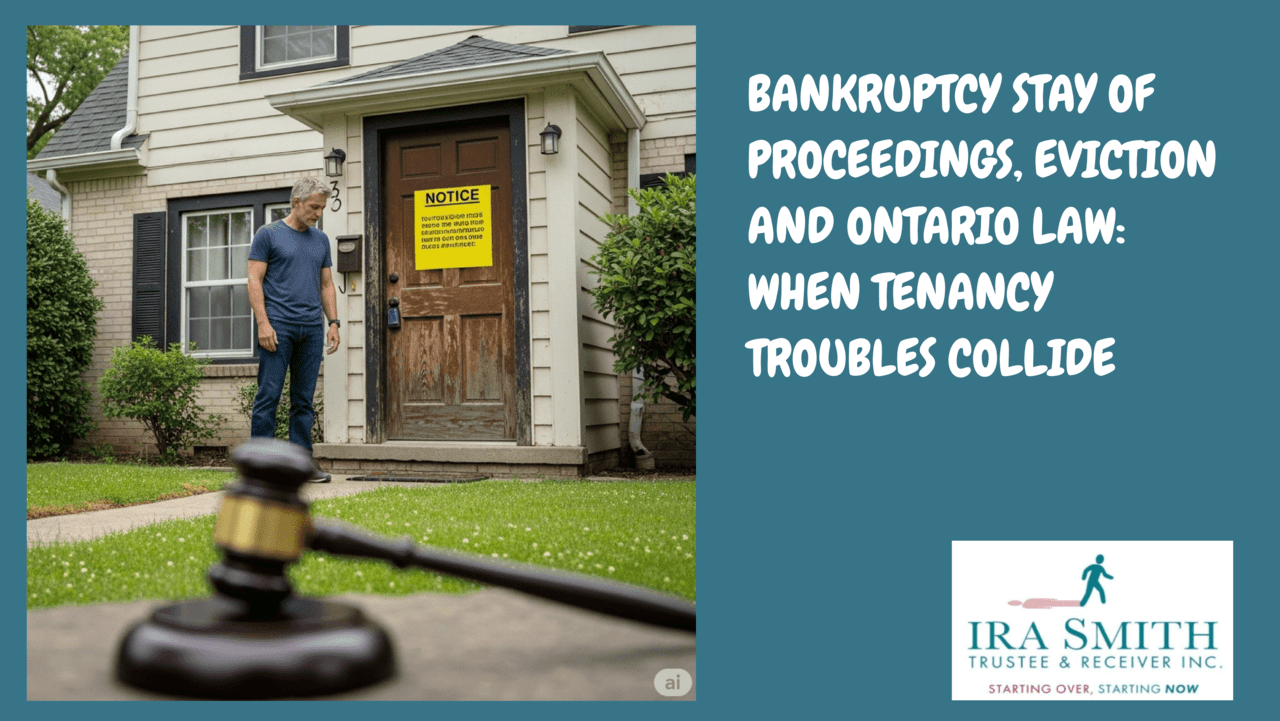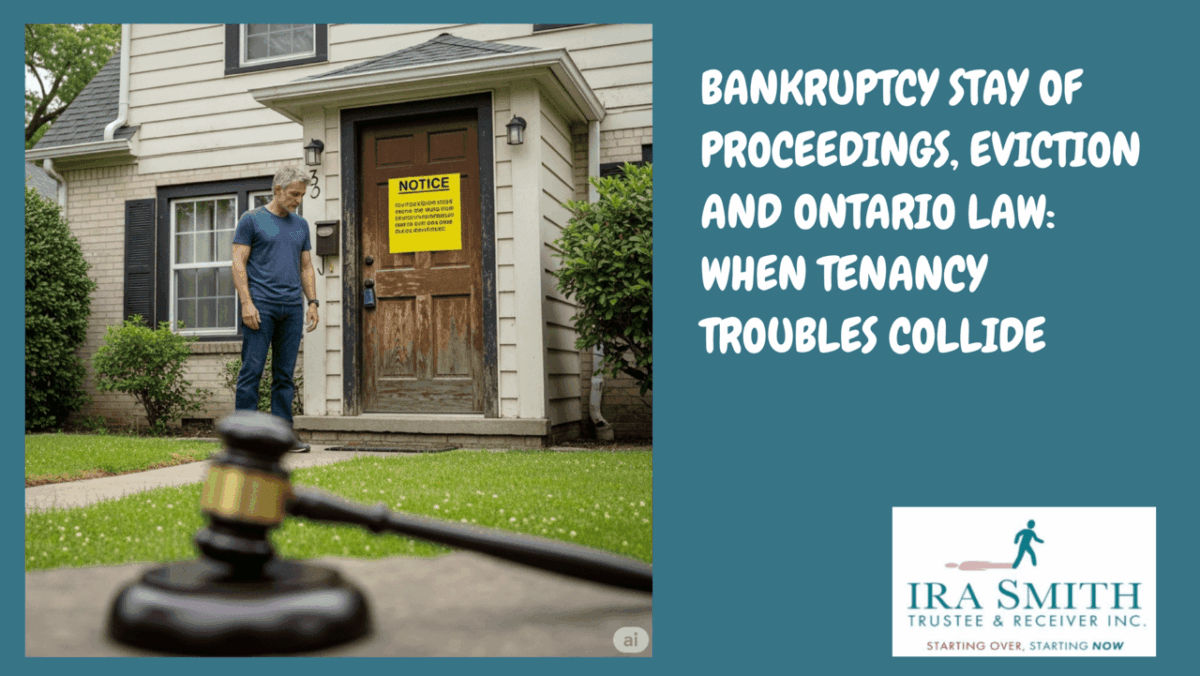Thank you for reading our Brandon's Blog. Check out our AI insolvency bot on this page and don't forget to subscribe!
- What is a Stay of Proceedings?
- Understanding Stay of Proceedings in Canada
- Stay of Proceedings and Eviction: A Real Ontario Case
- When Stay of Proceedings Doesn't Apply
- Stay of Proceedings: What Tenants Need to Know
- Stay of Proceedings: What Landlords Should Know
- Consumer Proposals vs. Bankruptcy: Stay Differences
- Professional Guidance: Why You Need a Licensed Insolvency Trustee
- FAQs About Stay of Proceedings
- Getting Help with Stay of Proceedings Issues
What is a Stay of Proceedings?
A stay of proceedings is like hitting the pause button on debt collection. When you file an assignment in bankruptcy, a consumer proposal or a Notice of Intention To Make A Proposal in Ontario, this legal protection automatically stops most unsecured creditors from taking collection action against you. If a claim is one purely for the collection of a debt advanced by one or more unsecured creditors, otherwise known as a claim provable in a bankruptcy or consumer proposal, then the stay of proceedings applies. But what happens when the legal action is not for the collection of a debt, like when an eviction is involved? A recent Ontario court case shows how complex this can get.
Understanding Stay of Proceedings in Canada
The Basics of Stay Protection
Under Canada’s Bankruptcy and Insolvency Act (BIA), a stay of proceedings provides immediate relief from:
- Debt collection lawsuits
- Wage garnishments
- Asset seizures
- Harassing creditor collection calls and collection agency calls
This protection starts the moment you file for bankruptcy or a consumer proposal with a Licensed Insolvency Trustee in your bankruptcy jurisdiction.
How Long Does a Stay of Proceedings Last?
The duration depends on your filing type:
- First-time bankruptcy: Usually 9 months (21 months with surplus income)
- Consumer proposal: Remains active while you make payments (up to 5 years)
- Notice of Intention To Make A Proposal: This is a preliminary filing before filing a restructuring Division One Proposal for the benefit of creditors, where you don’t qualify to make a consumer proposal. The timeline is similar to that of a consumer proposal

Stay of Proceedings and Eviction: A Real Ontario Case
The Snaith Case: What Happened
A recent Ontario Superior Court of Justice – Ontario In Bankruptcy and Insolvency case (Re Snaith, 2025 ONSC 3413) shows what happens when bankruptcy meets eviction. Here’s the story:
Leanna Mae Snaith owed $46,250 in rent arrears by January 2025. Despite making some payments, she couldn’t catch up. The Landlord and Tenant Board ordered her eviction unless she paid $47,986 by February 28, 2025.
When Ms. Snaith couldn’t pay, she filed for bankruptcy in April 2025, hoping the stay of proceedings would stop her eviction.
Why the Stay Didn’t Stop the Eviction
The court made several key points:
- Eviction orders aren’t debt collection: The tenancy was already terminated before bankruptcy
- Post-bankruptcy rent must be paid: New rent after filing isn’t discharged in bankruptcy
- Prior court orders remain valid: The eviction order was made before the bankruptcy filing
When Stay of Proceedings Doesn’t Apply
Exceptions to Stay Protection
A stay of proceedings doesn’t stop everything. It doesn’t apply to:
- Criminal court cases
- Family support payments (child support, spousal support)
- Some secured creditor actions
- Eviction enforcement when the tenancy was already terminated
Getting Around Stay Protection
Creditors can ask the court to “lift the stay” in certain situations. Under the BIA, the court has the authority to lift the stay if the person requesting the authority to begin or continue their action is likely to suffer material prejudice or if it is equitable on other grounds.
However, in eviction cases, landlords often don’t need to do this if the tenancy ended before bankruptcy.
Stay of Proceedings: What Tenants Need to Know
Can Bankruptcy Stop My Eviction?
The short answer: probably not if you’re already facing eviction.
- Before eviction proceedings: A stay might pause the process temporarily
- After eviction order: The stay won’t usually stop enforcement
- Current rent: You must keep paying rent during bankruptcy
Smart Strategies for Rent Problems
If you’re behind on rent:
- Act early: File for bankruptcy or a consumer proposal before eviction proceedings start
- Keep paying current rent: Post-filing rent isn’t protected by the stay
- Get professional help: Licensed Insolvency Trustees understand these complex rules
Stay of Proceedings: What Landlords Should Know
Your Rights During Tenant Bankruptcy
As a landlord, you should know:
- Pre-bankruptcy rent arrears: These become unsecured debts in bankruptcy
- Post-bankruptcy rent: Fully collectible and can lead to eviction
- Eviction timing: File early to avoid stay complications
Working with Sheriff’s Offices
The Snaith case revealed confusion even among enforcement officers. Some sheriff’s offices won’t enforce evictions during bankruptcy, even when they legally can. You might need a court order confirming your right to proceed as was the case here.
Consumer Proposals vs. Bankruptcy: Stay Differences
Consumer Proposal Stay Benefits
A consumer proposal offers a stay of proceedings while potentially providing better outcomes:
- Keep your home (if you can afford the payments)
- Paying a portion of your debts
- Protection lasts for the duration of the consumer proposal as long as you are meeting your payment obligations (usually up to 5 years)
Bankruptcy Stay Limitations
Bankruptcy provides immediate stay protection, but:
- You will lose non-exempt assets
- Post-bankruptcy obligations remain
- Unless there are extenuating circumstances causing a longer period, the bankrupt will normally be discharged between 9 months (first time bankruptcy and no surplus income) and 21 months (first time bankruptcy with surplus income requirement)
Professional Guidance: Why You Need a Licensed Insolvency Trustee
Expert Navigation of Stay Rules
The Snaith case shows how complex stay of proceedings rules can be. As Licensed Insolvency Trustees in the Greater Toronto Area, we help by:
- Explaining how stays apply to your specific situation
- Timing filings for maximum protection
- Handling creditor communications
- Ensuring compliance with legal requirements
Avoiding Common Mistakes
Many people misunderstand stay protection. We’ve seen clients assume bankruptcy solves everything, only to face continued problems with:
- Housing costs
- Post-filing obligations
- Non-dischargeable debts

FAQs About Stay of Proceedings
Does a stay of proceedings stop all creditors?
No. While most creditors must stop collection, some exceptions exist. Secured creditors, family support, and certain government actions may continue.
Can I get evicted during bankruptcy?
Yes, especially if eviction proceedings started before bankruptcy or if you don’t pay current rent.
How quickly does stay protection start?
Stay of proceedings protection begins immediately upon filing bankruptcy or a consumer proposal.
What happens if I violate the stay conditions?
Courts can lift the stay, removing your protection and allowing creditor actions to resume.
Getting Help with Stay of Proceedings Issues
If you’re facing debt problems and potential eviction, don’t wait. Early action often provides better options and stronger stay of proceedings protection. The longer you wait, the fewer options you might have. Contact a Licensed Insolvency Trustee today for a free consultation.
At Ira Smith Trustee & Receiver Inc., we’ve helped Ontario residents and companies overcome their debt challenges, starting with honest, professional advice. We’ll review your complete financial situation, explain all your options, and help you choose the best path forward.
Remember: you don’t need to pay someone to access professional help. Our help starts with a free consultation and continues with transparent, regulated services designed to get you back on your financial feet.
You’re not alone in this. There’s a path forward, and it starts with reaching out for the right kind of help. Take that step—you deserve it. If you’re a GTA resident dealing with overwhelming debt, don’t wait for your credit situation to get worse. As a licensed insolvency trustee serving Toronto, Mississauga, Brampton, Markham, and surrounding areas, I’m here to help you understand your options.
Remember: Your current financial situation doesn’t define your future. With the right help and information, you can overcome debt challenges.
As a licensed insolvency trustee serving the Greater Toronto Area, I encourage consumers and business owners to view financial difficulties not as failures but as challenges that can be addressed with proper guidance. By understanding the warning signs of insolvency and seeking professional advice early, many people and businesses can find a path forward – whether through restructuring, strategic changes, or in some cases, an orderly wind-down that protects their future opportunities.
Remember: The earlier you seek help for company insolvency concerns, the more options you’ll have.
If you or someone you know is struggling with too much debt, remember that the financial restructuring process, while complex, offers viable solutions with the right guidance. As a licensed insolvency trustee serving the Greater Toronto Area, I help entrepreneurs understand their options and find a path forward during financial challenges.
At the Ira Smith Team, we understand the financial and emotional components of debt struggles. We’ve seen how traditional approaches often fall short in today’s economic environment, so we focus on modern debt relief options that can help you avoid bankruptcy while still achieving financial freedom.
The stress of financial challenges can be overwhelming. We take the time to understand your unique situation and develop customized strategies that address both your financial needs and emotional well-being. There’s no “one-size-fits-all” approach here—your financial solution should be as unique as the challenges you’re facing.
If any of this sounds familiar and you’re serious about finding a solution, reach out to the Ira Smith Trustee & Receiver Inc. team today for a free consultation. We’re committed to helping you or your company get back on the road to healthy, stress-free operations and recover from financial difficulties. Starting Over, Starting Now.
The information provided in this blog is intended for educational purposes only. It is not intended to constitute legal, financial, or professional advice. Readers are encouraged to seek professional advice regarding their specific situations. The content should not be relied upon as a substitute for professional guidance or consultation. The author, Ira Smith Trustee & Receiver Inc., and any contributors do not assume any liability for any loss or damage.

